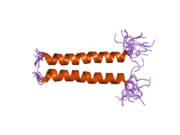Biology:T-cell surface glycoprotein CD3 zeta chain
 Generic protein structure example |
T-cell surface glycoprotein CD3 zeta chain also known as T-cell receptor T3 zeta chain or CD247 (Cluster of Differentiation 247) is a protein that in humans is encoded by the CD247 gene.[1]
Some older literature mention a similar protein called "CD3 eta" in mice. It is now understood to be an isoform differing in the last exon.[2]
Genomics
The gene is located on the long arm of chromosome 1 at location 1q22-q25 on the Crick (negative) strand. The encoded protein is 164 amino acids long with a predicted weight of 18.696 kiloDaltons.
Function
T-cell receptor zeta (ζ), together with T-cell receptor alpha/beta and gamma/delta heterodimers and CD3-gamma, -delta, and -epsilon, forms the T-cell receptor-CD3 complex. The zeta chain plays an important role in coupling antigen recognition to several intracellular signal-transduction pathways. Low expression of the antigen results in impaired immune response. Two alternatively spliced transcript variants encoding distinct isoforms have been found for this gene.[3]
Interactions
CD247 has been shown to interact with Janus kinase 3[4] and Protein unc-119 homolog.[5]
See also
References
- ↑ "Molecular cloning and chromosomal localization of the human T-cell receptor zeta chain: distinction from the molecular CD3 complex". Proc. Natl. Acad. Sci. U.S.A. 85 (24): 9709–13. December 1988. doi:10.1073/pnas.85.24.9709. PMID 2974162. Bibcode: 1988PNAS...85.9709W.
- ↑ "CD3 eta and CD3 zeta are alternatively spliced products of a common genetic locus and are transcriptionally and/or post-transcriptionally regulated during T-cell development". Proceedings of the National Academy of Sciences of the United States of America 88 (12): 5202–6. June 1991. doi:10.1073/pnas.88.12.5202. PMID 1828894.
- ↑ "Entrez Gene: CD247 CD247 molecule". https://www.ncbi.nlm.nih.gov/sites/entrez?Db=gene&Cmd=ShowDetailView&TermToSearch=919.
- ↑ "Cytokine-independent Jak3 activation upon T cell receptor (TCR) stimulation through direct association of Jak3 and the TCR complex". J. Biol. Chem. 276 (27): 25378–85. Jul 2001. doi:10.1074/jbc.M011363200. PMID 11349123.
- ↑ "Unc119, a novel activator of Lck/Fyn, is essential for T cell activation". J. Exp. Med. 199 (3): 369–79. Feb 2004. doi:10.1084/jem.20030589. PMID 14757743.
Further reading
- "Structure--function relationships in HIV-1 Nef.". EMBO Rep. 2 (7): 580–5. 2001. doi:10.1093/embo-reports/kve141. PMID 11463741.
- "HIV-1 Nef control of cell signalling molecules: multiple strategies to promote virus replication.". J. Biosci. 28 (3): 323–35. 2004. doi:10.1007/BF02970151. PMID 12734410.
- "Modelling thymic HIV-1 Nef effects.". Curr. HIV Res. 4 (1): 57–64. 2006. doi:10.2174/157016206775197583. PMID 16454711.
External links
- CD247+protein,+human at the US National Library of Medicine Medical Subject Headings (MeSH)
- Human CD247 genome location and CD247 gene details page in the UCSC Genome Browser.
- Overview of all the structural information available in the PDB for UniProt: P20963 (Human T-cell surface glycoprotein CD3 zeta chain (CD247)) at the PDBe-KB.
 |


